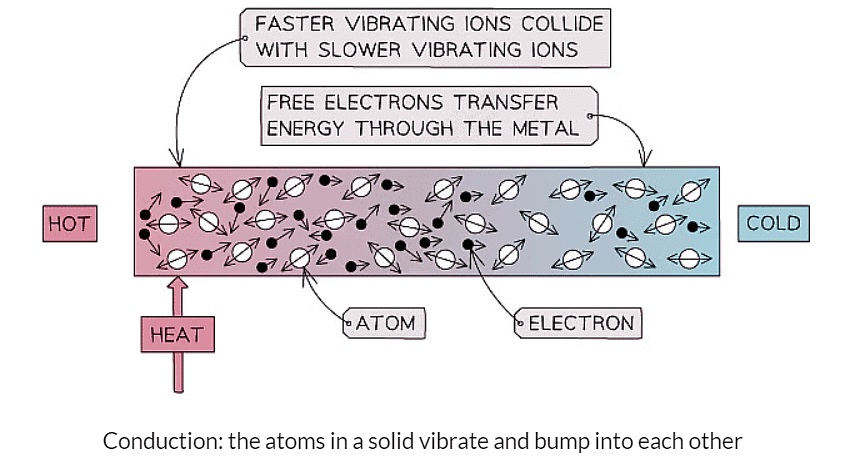Class 10 Exam > Class 10 Notes > Physics for GCSE/IGCSE > Thermal Conduction
Thermal Conduction | Physics for GCSE/IGCSE - Class 10 PDF Download
Thermal Conduction in Solids
- Conduction is the primary method of thermal energy transfer in solids.
- It occurs when two solids of different temperatures come in contact, transferring thermal energy from the hotter object to the cooler one.
- Metals are exceptional thermal conductors due to their high number of free electrons.
- This characteristic enables them to effectively transfer thermal energy.

- Conduction occurs through two mechanisms: atomic vibrations and free electron collisions.
- Atomic vibrations: Atoms in a solid vibrate as they are heated, transferring energy.
- Free electron collisions: Electrons move and collide, also transferring energy.
- Heating a substance leads to increased movement (vibration) of its atoms or ions.
- Atoms situated in the hotter portion of the solid exhibit greater vibrational motion compared to those in the cooler section.
- This heightened motion results in collisions between atoms, facilitating the transfer of energy from one atom to another.
- Through these collisions, internal energy is passed along until the substance reaches a state of thermal equilibrium.
- This process is universal, occurring in all types of solids, regardless of whether they are metals or non-metals.
Thermal Conduction in Liquids & Gases
- Thermal conduction requires particles to be in proximity so that vibrations can propagate.
- Fluids, however, don't facilitate this process efficiently.
- In liquids, although particles are close, they slide past each other instead of transmitting vibrations.
- Gases, with widely spaced particles, lack the capacity to nudge each other effectively.
- Consequently, both types of fluids, liquids, and gases, exhibit poor heat conductivity.
Question for Thermal ConductionTry yourself: In which type of substance does thermal conduction occur most effectively?View Solution
Relative Thermal Conductivity
- Metals are typically known as conductors.
- Enhanced thermal conductivity is attributed to materials possessing delocalized electrons, facilitating efficient energy transfer.
- Consequently, there exists a broad spectrum of thermal conductivity among materials.

The document Thermal Conduction | Physics for GCSE/IGCSE - Class 10 is a part of the Class 10 Course Physics for GCSE/IGCSE.
All you need of Class 10 at this link: Class 10
|
129 videos|148 docs|35 tests
|
FAQs on Thermal Conduction - Physics for GCSE/IGCSE - Class 10
| 1. How does thermal conduction differ in solids compared to liquids and gases? |  |
Ans. In solids, thermal conduction occurs through the vibration and movement of particles which pass on kinetic energy to neighboring particles. In liquids and gases, thermal conduction occurs through the transfer of heat energy by the movement of particles from higher temperature regions to lower temperature regions.
| 2. What factors affect the rate of thermal conduction in solids? |  |
Ans. The rate of thermal conduction in solids is affected by factors such as the material's thermal conductivity, temperature gradient, thickness of the material, and surface area.
| 3. Why do metals typically have higher thermal conductivity compared to non-metals? |  |
Ans. Metals have higher thermal conductivity compared to non-metals because they have more free electrons that can easily transfer heat energy through the material, whereas non-metals have fewer free electrons which hinder the transfer of heat.
| 4. How does thermal insulation work to reduce thermal conduction in buildings? |  |
Ans. Thermal insulation works by trapping air pockets within its material, which reduces the movement of particles and slows down the transfer of heat energy through conduction, helping to maintain a stable temperature inside buildings.
| 5. Can thermal conduction be completely prevented in solids, liquids, and gases? |  |
Ans. While thermal conduction can be minimized through insulation and other methods, it cannot be completely prevented in solids, liquids, and gases as heat energy will always attempt to move from higher temperature regions to lower temperature regions through the transfer of kinetic energy.
Related Searches




















